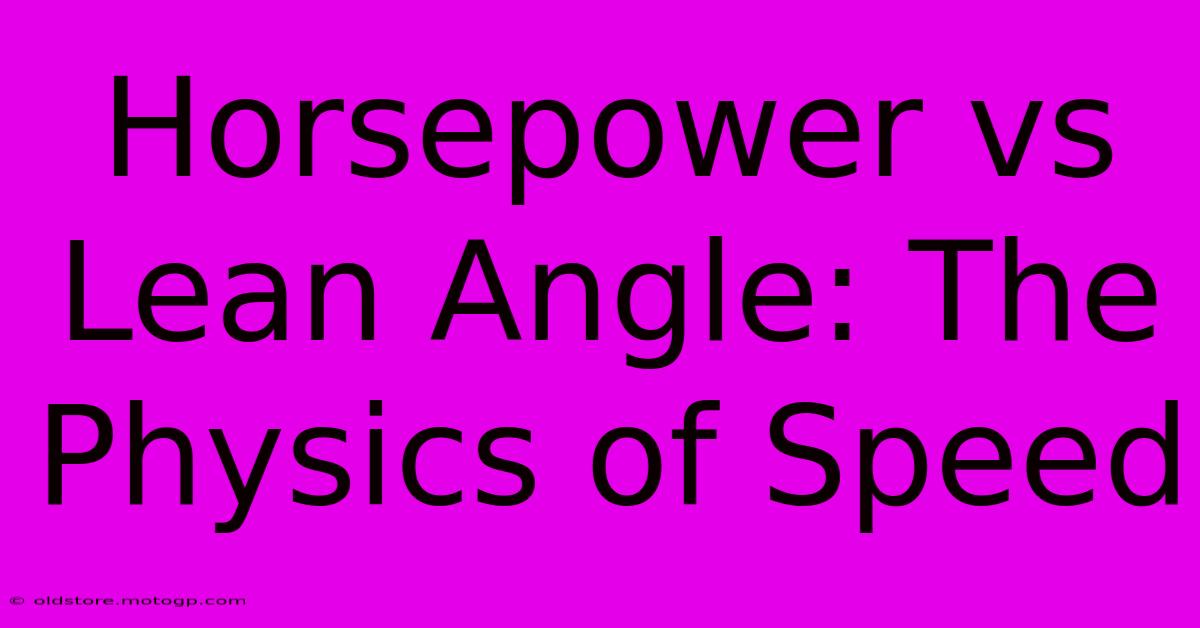Horsepower Vs Lean Angle: The Physics Of Speed

Table of Contents
Horsepower vs. Lean Angle: The Physics of Speed
For motorcycle enthusiasts, the pursuit of speed is a captivating challenge. But speed isn't solely determined by raw horsepower. Understanding the interplay between horsepower and lean angle – the physics of speed – is crucial for maximizing performance and safety. This article delves into the intricate relationship between these two critical elements, explaining how they contribute to a motorcycle's velocity and handling.
The Role of Horsepower
Horsepower, a measure of an engine's power output, is the fundamental force propelling the motorcycle forward. A higher horsepower engine translates to greater acceleration and a higher top speed. Think of it as the engine's ability to overcome resistance – air resistance, friction, and inertia. A powerful engine can more readily accelerate the motorcycle to higher speeds and maintain those speeds on inclines or against headwinds.
Horsepower Limitations:
However, horsepower alone doesn't tell the whole story. Even the most powerful engine will struggle if it can't effectively transfer its power to the road. This is where lean angle comes into play.
The Significance of Lean Angle
Lean angle refers to the degree to which a motorcycle is tilted into a turn. It's a critical factor in cornering speed and overall handling. Leaning allows the motorcycle to navigate curves by transferring weight and adjusting the contact patch of the tires.
Lean Angle and Traction:
The maximum lean angle is dictated by several factors, including:
- Tire grip: The type of tire rubber and its condition significantly impact grip. Worn tires or unsuitable tires for the conditions (wet vs. dry) will drastically reduce the maximum lean angle before the tires lose traction and the motorcycle slides.
- Road surface: Smooth, dry asphalt provides far more grip than loose gravel or a wet road. Lean angle needs to be adjusted according to the road surface conditions for safe riding.
- Motorcycle geometry: The motorcycle's chassis design, wheelbase, and rake angle all influence how much it can lean before losing stability.
- Rider skill: A skilled rider can maintain control at higher lean angles than a novice. Experience and proper training are vital for safe and effective leaning.
Lean Angle and Centripetal Force:
When a motorcycle leans, it generates centripetal force. Centripetal force is the force that keeps an object moving in a circular path. This force is crucial for navigating turns; without it, the motorcycle would continue in a straight line and leave the road. The greater the lean angle, the greater the centripetal force, and the tighter the turn that can be taken at speed.
The Interplay of Horsepower and Lean Angle
The relationship between horsepower and lean angle is complex but essential to understanding high-speed riding.
-
High Horsepower, Moderate Lean Angle: A powerful engine allows for higher speeds in straights, but excessive speed entering a turn necessitates a sharper lean angle. This pushes the limits of tire grip, potentially leading to a loss of control if the lean angle is too extreme for the given conditions.
-
Moderate Horsepower, Precise Lean Angle: A motorcycle with moderate horsepower relies on precise lean angle control for navigating turns effectively. Riders must skillfully manage their speed and lean angle to maximize cornering speed.
-
Optimizing Performance: The optimal balance lies in understanding the limitations of both horsepower and lean angle within the context of riding conditions and rider skill. A skilled rider will smoothly modulate the throttle, precisely controlling acceleration and deceleration, to complement the lean angle, ensuring maximum speed through corners.
Conclusion: Mastering the Balance
Mastering speed on a motorcycle is not simply about maximizing horsepower; it’s about understanding the delicate balance between raw power and controlled lean angle. Understanding the physics behind both is crucial for safe, efficient, and exhilarating riding. Remember, respecting the limits of both your motorcycle and your own skill is paramount for a positive riding experience. Always ride within your limits and adjust your riding style according to the conditions.

Thank you for visiting our website wich cover about Horsepower Vs Lean Angle: The Physics Of Speed. We hope the information provided has been useful to you. Feel free to contact us if you have any questions or need further assistance. See you next time and dont miss to bookmark.
Featured Posts
-
Experience The Culture Of Moto Gp With Nbc
Feb 23, 2025
-
Moto Gp Photos An Inside Look At The World Of Racing
Feb 23, 2025
-
Moto 2 Bike Specs Take Your Riding To The Next Level
Feb 23, 2025
-
F1 Austin Your Parking Checklist
Feb 23, 2025
-
Austin Gp Concert The Best Way To Experience The Austin Grand Prix
Feb 23, 2025
